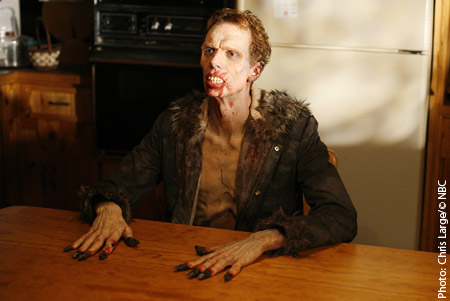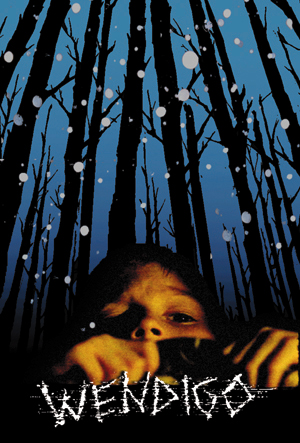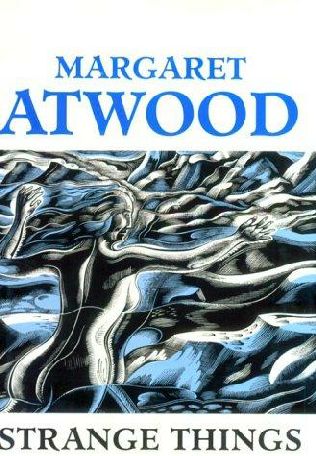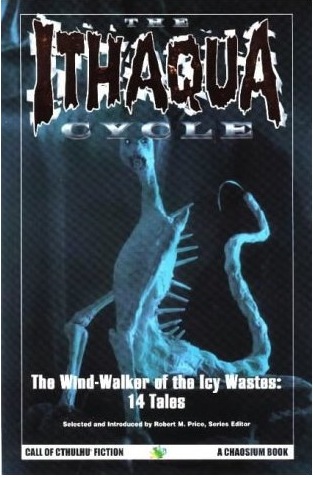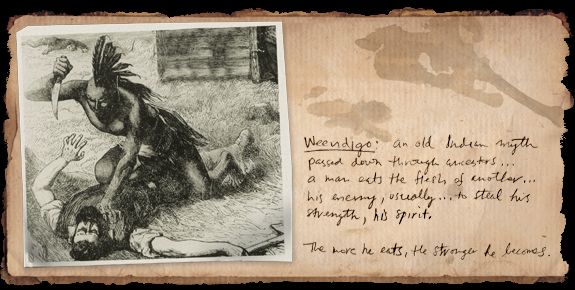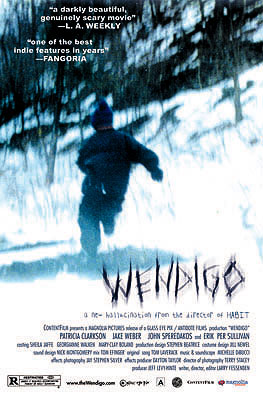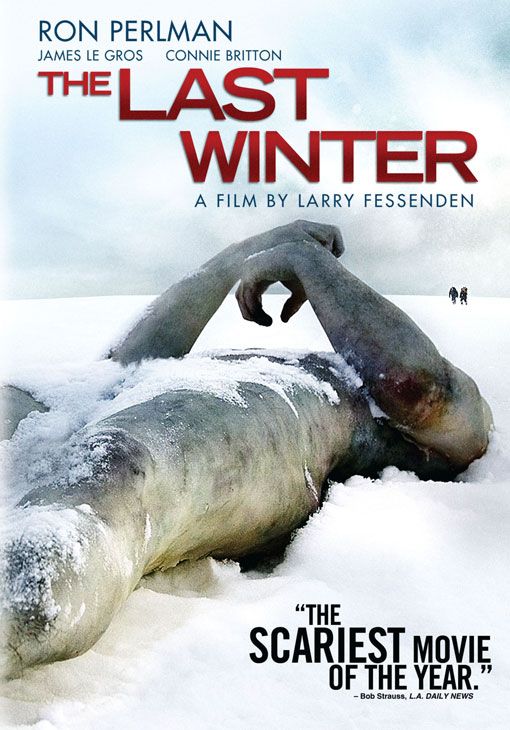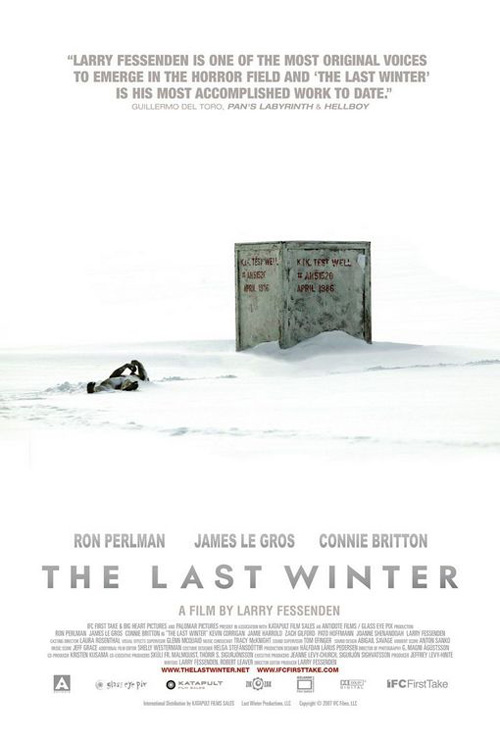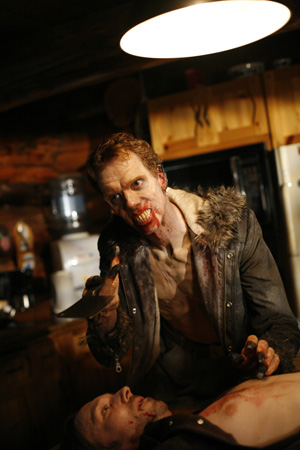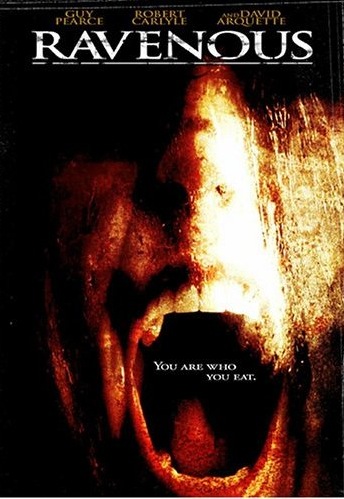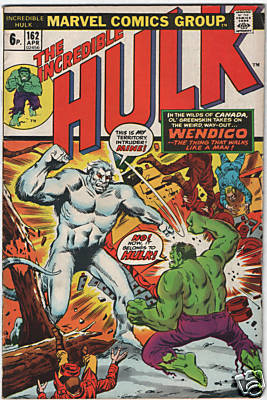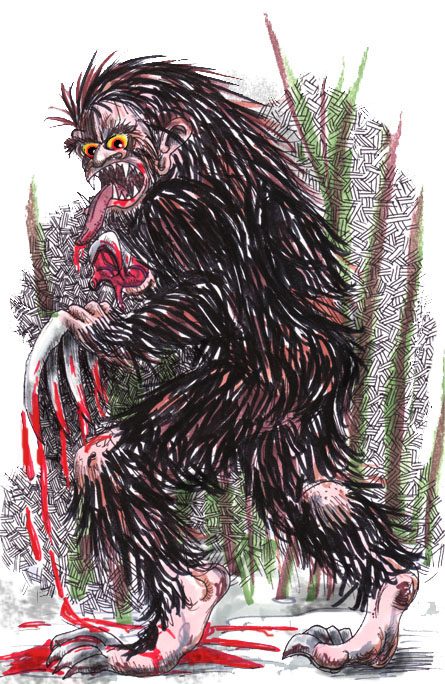Larry Fessenden and the Spirits of the Lonely Places
Wednesday, August 20, 2008
posted by Steve Tompkins
 Print This Post
Print This Post
Deep silence fell about the little camp, planted there so audaciously in the jaws of the wilderness. The lake gleamed like a sheet of black glass beneath the stars. The cold air pricked. In the draughts of night that poured their silent tide from the depths of the forest, with messages from distant ridges and from lakes just beginning to freeze, there lay already the faint, bleak odour of coming winter.
Algernon Blackwood, “The Wendigo”
The small screen can deliver big scares; Eric Kripke has been proving that more often than not for two full seasons and a strike-shortened third with Supernatural. That show, in which two brothers drive the unluckiest backroads of the American night while being driven by a family mission that asks too much of them, crashes through The CW’s sugar-and-spice-and-spite like a classic rock power chord. And at least half the episodes of Mick Garris’ Masters of Horror were good unclean fun; sixty minutes without commercials can amount to the functional equivalent of a novelette, if not a novella. When Showtime wasn’t interested in a third season, the MOH auteurist anthology approach lived to affright another day as Fear Itself, eight episodes of which aired this summer before NBC switched to scaring us with flexi-dwarf gymnasts instead. As soon as the opening credits of “Skin and Bones,” the episode shown on the night of Thursday, July 31, revealed that the director du semaine was Larry Fessenden, I began hoping for a particular monster with which Fessenden has worked almost as often as did Scorsese with De Niro. . .the rottenest tooth in a knowing primordial grin, the blackness at the core of the rampaging blizzard.
At the start of “Skin and Bones” (written by Drew McWeeny and Scott Swan. who also scripted one of my favorite Masters of Horror episodes, the John Carpenter-directed “Cigarette Burns”), the ranch-owning but city-dwelling Grady Edlund has been missing for 10 wintry days. He returns as the only surviving member of a party that unwisely elected to ride the high country in the teeth of a storm, and even while indoors, bed-ridden and being cared for by his wife, sons, and brother, reeks of . . .externality, of having come back wrong. If Famine rather redundantly put itself on a starvation diet, the result might look like Grady, who is played by Doug Jones, an actor-turned-human-canvas worthy of the best efforts of a Bernie Wrightson or Gahan Wilson, perhaps even a Goya or Bosch; as Larry Fessenden proudly notes of his “Skin and Bones” work “He is the special effect.”
Jones was the leering, heart-harvesting lead Gentleman in the still watches of Joss Whedon’s “Hush,” a standout fourth season Buffy episode closer to pure horror than the show usually ventured, and has covered himself with both makeup and glory for Guillermo del Toro as the Faun and the Pale Man in Pan’s Labyrinth and Abe Sapien and the Angel of Death in the Hellboy films.
Grady’s convalescence is merely a cat-and-mouse divertissement, and his family, already semi-freaked by the black talons frostbite has made of his fingertips and the way the majority of his face has been reduced to lips for hypercarnivorous teeth, grows even more jittery as his words and actions seem to lick and sniff them in some sort of predator’s foreplay. “He’s been through hell is all,” brother Rowdy seeks to reassure his sister-in-law; he is of course overly optimistic about the extent to which her husband has escaped from that hell. More unwittingly accurate are his words to Grady himself: “Whatever it is that’s eating you, you don’t let it go, it’ll devour you.” The Edlunds’ décor is much as we might expect for a Rocky Mountain ranchhouse; frozen-snarled examples of the taxidermist’s art provide voiceless testimony about the dangers of slipping on the food chain throughout the hour.
A midnight mare-mutilation and a howl like emptiness becoming aware of itself convince ranch hand Eddie Bear it’s time to brief Rowdy on a “spirit of the lonely places, a hateful thing that lives in the cold winds of the high mountains.” This entity, “a hunger that can’t be satisfied, an anger that can’t be settled,” is of course the Wendigo. On his commentary track for the DVD of his 2006 film The Last Winter Fessenden has a little fun at his own expense: “Of course this movie is haunted yet again by the Wendigo, my beloved Wendigo, which has done untold damage to my career in my endless attempts to portray [it].” And that was before “Skin and Bones,” which, on top of not only The Last Winter but also Wendigo (2001), makes Fessenden to ice-hearted windwalkers what Leon Edel was to Henry James, what Joseph Frank was to Dostoevsky, and what Martin Gilbert was to Winston Churchill: an official biographer.
Doug Jones’ Grady brings a passage from the Ojibwa scholar Basil Johnson to deathly life:
The Wendigo was gaunt to the point of emaciation, its desiccated skin pulled tautly over its bones. With its bones pushing out against its skin, its complexion the ash gray of death, and its eyes pushed back deep into their sockets, the Wendigo looked like a gaunt skeleton recently disinterred from the grave.
But Wendigos can be metamorphic as well as anthropomorphic; they’re protean, shapeshifters, like Myth itself. “Part wind, part tree, part man, part beast,” is Fessenden’s description of the version that “can fly at you like a sudden storm” in his 2001 film. My favorite imagery, not counting Algernon Blackwood’s definitive 1910 story, can be found in Paulette Jiles’ poem “Windigo” and Peter Davidson’s indispensable omnium gatherum The Idea of North (2004). First Jiles:
He is the Hungry Man, the one who reached this wasteland of
The soul and did not emerge. . .
Davidson for his part concludes “Wendigos are people who have crossed that invisible but fatal barrier that divides the natural from the supernatural north.” The idea of a supernatural north wholly separate from the one where Jotunheim and Asgard confront each other, a region about which Robert W. Service and Jack London might have surmised more than they were ever willing to say, is a powerful one, marvelously surveyed in Margaret Atwood’s Strange Things: The Malevolent North in Canadian Literature. (1995).
Is a little nativism pardonable when it comes to monster-preferences? The Wendigo is not just From Here, he’s Here Itself. Even when vampires thrive in the young towns and cities of the New World — think ‘Salem’s Lot, They Thirst, The Light at the End — Stephen King, Robert R. McCammon and John Skipp and Craig Spector have to acknowledge their Carpathian or Balkan roots; they were nosferatu before they became what Joss Whedon called “undead Americans.” Werewolves undergo the naturalization process in Whitley Strieber’s The Wolfen (1978). S. P. Somtow’s Moon Dance (1989), and Nancy A. Collins’ Walking Wolf (1995), but words like lycanthrope and loup-garou betray origins in the Forest of Villefere or a similar locality.
August Derleth ill-advisedly went out and threw a Mythos net over the Wendigo, whom he dubbed Ithaqua the Windwalker. “Bogart can be tough without a gun,” Raymond Chandler famously pointed out; similarly, a Wendigo doesn’t need the Mythos to be scary. The eventual and inevitable result was a Chaosium anthology, The Ithaqua Cycle: The Wind-Walker of the Icy Wastes (1999), in which Derleth’s weaknesses as a weird fictionist are copiously documented but Brian Lumley’s “Born of the Winds” actually merits a place alongside Blackwood’s classic.
Stephen King also undervalued the concept’s mythopoeic heft when he threw in a Wendigo as extra, and somewhat superfluous, spiritual toxicity for his Micmac burial ground in Pet Sematary (1983).
No, the lesson here is that all by their lonesome Wendigos are their own best context. Considering the nature, in more than one sense, of the horror at which he excelled, it’s doubtful that any genre writer has ever been as perfectly surnamed as Blackwood, the subject of Starlight Man: The Extraordinary Life of Algernon Blackwood, a 2001 biography by the indefatigability-redefining Mike Ashley. In “The Wendigo” his Scots divinity student explains his ordeal in the Candian wild “as a glimpse into prehistoric ages,” a revelation of “savage and formidable Potencies lurking behind the souls of men, not evil perhaps in themselves, yet instinctively hostile to humanity as it exists.” Along the same lines the Native American Elder who might or might not really be behind the pharmacy counter in Fessenden’s Wendigo says “Nothing between the earth and sky is bad, but there are spirits that should be feared” because of their hunger, and anger. As an Algonquin conception, Wendigos obviously preyed on Indians for centuries before Leif Ericson, Samuel de Champlain, or Henry Hudson ever showed up, but it can be darkly piquant to think of them as antibodies in the North American bloodstream neutralizing foreign, transatlantic pathogens.
Lovecraft deemed Blackwood “closely wedded to the idea of an unseen world constantly pressing on ours”; in Wendigo fiction ours becomes the unreal, artificialized world unwisely pressing upon a much more real one, one quite capable of striking back.
The promotional material for Wendigo invoked “laws you cannot know, legends you cannot believe, and a force you cannot fight.” It is some consolation that these spirits can’t be hunted to extinction or beaten and starved by circus trainers; their dreamscapes are impervious to suburban sprawl. “The younger man understood that in a hinterland of this size there might well be depths of wood that would never in the life of the world be known or trodden,” Blackwood writes — if only. Monsters create meaning, and Wendigos are meaningful not only due to being so domestication-resistant but because of a consistent hint of victim-complicity — in some lore-variants, the Wendigo has to be invited in, on a much more intimate basis than, say, a householder allowing a vampire across the threshold. In “Skin and Bones” Grady discloses that a voice spoke to him in subzero extremity: I’ll save you. Just let me in. And not only those who believe that wilderness requires “developing” are at risk; for Blackwood victims’ “most vulnerable points, moreover, are said to be the feet and the eyes; the feet, you see, for the lust of wandering, and the eyes for the lust of beauty. The poor beggar goes at such a dreadful speed that he bleeds beneath the eyes, and his feet burn.”
“It’s kind of the most traditional version of the Wendigo tale,” Fessenden said of “Skin and Bones” to Fangoria‘s Michael Gingold. A version he’d earned the right to assay after Wendigo and The Last Winter. His work has been called “arthouse horror,” the product of a “downtown sensibility”; comparisons to Val Lewton and the late “quiet horror” champion Charles L. Grant are more useful. Leery of corporate funding and kibitzing, Fessenden addresses pesticides, addiction, vivisection, and undeclared but vigorously waged class warfare in tone poems that are indeed quiet horror in that they provide the hush in which dread can take over. His films invite the audience to collaborate with him, rather than merely consume what is being spoon-fed to them.
Fessenden regards state-of-the-art CGI as yet another opiate of the masses; in Wendigo puppetry and other making-a-virtue-of-necessity low-grade FX and techniques like time-lapse photography and stutter-montage conjure an equivalent to Blackwood’s “Panic of the Wilderness. . .the power of untamed Distance — the Enticement of the Desolation that destroys.” The director said to MovieNetNews: “. . .Very simply, I grew up in New England, and the winters in Vermont visiting family and friends made a deep impression on me. Got to my soul. Same with the Wendigo.” The film transplants those winters to upstate New York, with its redundancies, its tautologies of snowfall, as a family of three, city-folk for whom a weekend in the country pretty much guarantees being weakened in the country, avail themselves of a friend’s farmhouse. The tragedies that befall them and the enemy they make of an embittered hunter during their stay could well be the pangs and shudders of a bereaved imagination belonging to a boy not unlike Danny Torrance.
We are near the Ashokan Reservoir, where the leavings of a subsistence economy based largely on hunting and trapping are being displaced by downstate demands; an earlier displacement, that of the area’s original Indian inhabitants, is still discernible. But the Wendigo — “It can grow tall as the trees and still it aches with hunger” — can return to fill the vacuum of displacement. . .In this film it is glimpsed as a bipedal demon-deer, the antlers of which cross associative oceans to evoke horned mythagos like Herne and Cernunnos:
Sometime a keeper here in Windsor Forest,
Doth all the winter-time, at still midnight,
Walk round about an oak, with great ragg’d horns;
And there he blasts the tree, and takes the cattle,
And makes milch-kine yield blood, and shakes a chain
In a most hideous and dreadful manner.
You have heard of such a spirit, and well you know
The superstitious idle-headed eld
Receiv’d, and did deliver to our age,
This tale of Herne the Hunter for a truth.
(The Merry Wives of Windsor)
The Last Winter (2006), as per Fessenden “an eco-horror film and a creature film and a ghost story and a cautionary tale,” asks “What if [our] guilt started manifesting itself in this dark north of the Arctic, where you imagine you could see things with the northern lights to help you?”
As in all the most effective entries in this type of horror, the characters are double-teamed by the negative energies at work within them as well as those playing with them from outside. The verdict of Conan of Cimmeria could be an epigraph for the film: “But that’s always the way when civilized men come into the wilderness. They’re all crazy as hell.”
The craziness this time is courtesy of North Industries, a company the very name of which invites retribution, and their slogan “Trust. Risk. Results,” heraldically accompanied on posters by an unusually demented-looking bald eagle, is no confidence-builder either. Seems Congress, sweating from a “Drill Here! Drill now!” fever that’s only too plausible in the snake-oily summer of 2008, has opened up the Arctic National Wildlife Refuge, which by being pristine is obviously just asking for it, its whiteness no more acceptable than a blank page would be to a graphomaniac.
Ron Perlman’s Ed Pollack is the ramrod for North Industries, a force of nature until he belatedly begins to understand what a literal Force of Nature might actually be like. Alaska’s weather has gotten not just unseasonably but un-regionally warm; the permafrost is melting, in the process disclosing not an alarming incongruity from someplace else, as in “Who Goes There?” or At the Mountains of Madness, but a genius loci with much to avenge. Black gold is as accursed as any other kind; one character, Zach Gilligan’s Maxwell, now perceives oil as not only a natural but a supernatural resource, a ghost story in that it consists of crushed biomass: “We’re grave robbers! They’re coming out of the ground. . .ghosts!” Watching all this is James Le Gros’ Hoffman, an environmentalist a little too in love with the notion of the biosphere turning on its tormenter to be a conventional good guy. ‘”There’s a fierceness in the wind I’ve never felt before,” and “There is no way home” are representative Hoffman journal-jottings.
On the commentary Fessenden confides:
Now this is all sort of a reference to the story “The Wendigo” by Algernon Blackwood, where one of the characters goes out and disappears for a long period of time and then when he comes back he’s changed forever, Défago. And when I made the film Wendigo I ironically hadn’t read the Blackwood, so that movie has nothing at all to do with the Blackwood story. He’s the most evocative writer of just mysterious natural phenomena that I’ve ever read. And I wanted to tribute his story “The Wendigo” with this film.
That he does; an Email is sent by “Défago Express,” and a character’s feet catch on fire, although the combustion is less supernatural than Blackwood’s. And the overall feel of the film could not be more Blackwoodian: “The presentiment of a nameless doom lurked ill-concealed behind every detail of what had happened.”
Fessenden freely cops to having been inspired by not just the subzero claustro-paranoia of Carpenter’s The Thing (1982) but also a masterpiece Alira Kurosawa managed to pull off under Soviet auspices when he was a cine-prophet without honor in his own country: Dersu Uzala (1975), the story of a Siberia-exploring Czarist officer befriended by a tribesman who saves his life again and again. Peter Weir’s The Last Wave goes unmentioned, although the sense that the slate is going to be wiped clean, that the Western way of being in the world is about to go West, is much the same at the end of each.
Despite the uptick in temperatures, North Industries’ can-do is frozen in its tracks by can’t. Reviewer Manohla Dargis was struck by Fessenden’s reveling in ‘his natural canvas and its negative space, playing with the depth of field, so that the whiteness either seems to stretch on forever or suddenly flatten, at times turning these fully dimensional human figures into silhouetted cutouts.” The whiteout of limbo or absolute abstraction, foolscap awaiting calligraphy or typeface, is so dominant that the sight of some scrubby, leafless, hunkered-down trees late in the proceedings is a shock. Wendigo manifestations and other anomalies, including an unkindness of ravens who may not be Odin’s Hugin and Munin — wrong North — but nevertheless know a defeated contingent when they see one, build to a final scene that furnishes merely the sonic details of what we are invited to imagine is a paradigm-shift on a Ballardian scale. Nature just might be the Greatest Old One of all.
Fessenden’s “Skin and Bones” burlesques the concepts of family dinners and family meetings as Grady forces his wife to prepare one of the most transgressive repasts since Atreus set a home-cooked meal before Thyestes; at one point he specifies “nice-sized chunks” of stew-meat.
In so doing the episode reminds us that for all its preeminence, Blackwood’s “The Wendigo” is . . .a little on the Vegan side, startlingly anthropophagy-free, almost a salad bar. Not so Antonia Bird’s Ravenous (1999), which grinningly suggests that the essential American soul is not only a killer but an eater.
Bird is best known in the U. S. for Priest (1994) a film that was treated as if she’d set off a neutron bomb in a seminary. She stepped in at the last minute to direct Ravenous, but achieved a weird Western that expands the possibilities of that subgenre as subversively if less apocalyptically as does Blood Meridian. Both the film and McCarthy’s novel take place right after the War With Mexico; part of the attraction of the former is the presentation of an antebellum West, before the iconic costumes and weapons — the misfits and rejects the U. S. Army has dumped at Fort Spencer in the western Sierra Nevadas are Winfield Scott’s bluecoats, not those of Sherman and Sheridan. Still, despite the quaintness I associate with an old-timey word like “dragoons,” the fort is an outpost of an empire that by devouring everything in its path serves as a role model for some of the characters screenwriter Ted Griffin creates.
A few years after Harry Flashman’s cowardice earns him a promotion, a medal and an undeserved patina of heroism in the First Afghan War, Captain John Boyd’s has done the same for him on a Mexican battlefield, but guilt eats at Boyd in a most un-Flashy-like fashion. Guy Pearce, who plays Boyd, has also found himself on the frontier between civilization and lawlessness in The Proposition (2005) and L. A. Confidential (1997). A disgusted superior officer banishes him to Fort Spencer, a former Spanish mission reconsecrated for more materialistic purposes: in the springtime, the fort will be a way station for tens of thousands of gold-hungry Americans. Fort Spencer is barely tolerated by the surrounding powers of stone and snow, as robed in animist auctoritas as the mountains that dispatch Clint Eastwood’s Preacher into the human world (and swallow him up again at film’s-end) in Pale Rider. So it’s disappointing to learn that the filmmakers passed off the Tatras Mountains of Slovakia as the Sierra Nevadas; even the location shooting for a genius loci like the Wendigo gets outsourced in this day and age.
The movie splits the difference between the monstrous Wendigo, introduced as “an old Indian myth from the north” and dismissed as “the stuff of campfires,” and the “windigo psychosis” that has been known to afflict the culturally predisposed, like members of the Cree people; but here the psychosis has a verifiable payoff in terms of speed, strength, and wound-defying survival. Like Doug Jones in “Skin and Bones,” Robert Carlyle’s cannibal, a former tubercular and recent-convert exponent of “the potency of someone else coursing through your veins,” is a nonpareil special effect, a theriomorph without benefit of transformation scene to rank with his Begbie in Trainspotting (1996). Ravenous is tinted with black comedy, at times unsubtly so, as with the fort’s lone super-soldier, who is not only blond but named Reich, while “He was tough. But then a good soldier ought to be” is another butcheree’s epitaph. A better joke is that Carlyle’s character, having split up, picked off, and dined on most of Fort Spencer’s garrison, reappears as “Colonel Ives,” a newly-appointed interim commanding officer. Ultimately a visiting general helps himself to a ladleful of what he finds simmering in the stew-pot; perhaps Wendigoism will gradually spread up the chain of command and even back east (which would explain a lot about the administration of James Buchanan, the worst president never to have owned a baseball team).
Carlyle’s finest moment comes when he points to Manifest Destiny and the tide of westward expansion while trying to sell Pearce on the new lifestyle: “This country is stretching out it’s arms and consuming all it can. We merely follow.”
But the ice of self-loathing in which Captain Boyd has been frozen is melting at long last, and a confrontation ensues about which Antonia Bird has confessed ‘I wanted it to be John Woo.” Well, not quite, but the use of sabers, logs, pitchforks, bayonets, cleavers, and a bear trap big enough enough to catch a carnosaur had me harking back to the Lee Marvin/Ernest Borgine showdown in Emperor of the North Pole (1973).
“What I love about the Wendigo is that there are so many ways to tell that story,” Fessenden said to Michael Gingold. Marvel Comics veterans will recall an Incredible Hulk guest shot that did even less justice to the creature than August Derleth managed:
No better Wendigo-tale, short form, than Blackwood’s is likely to appear anytime soon, which leaves long form open. Only the technicality that the demon of Dan Simmons’ The Terror (2007) is drawn from Inuit rather than Algonquin mythology and takes the white-furred form of a larger, faster, crueler lord of the ice-floes prevents the novel from being the greatest Wendigo story ever told. Movie-wise before Ravenous, Wendigo, and The Last Winter there was Frostbiter: Wrath of the Wendigo, released in 1996 but judging by the bigness of the actresses’ hair, filmed at the height of the Eighties. The film is set on Manitou Island of Michigan’s Upper Peninsula and wears its white-trashiness on its hunting-jacketed sleeve; the doofuses-in-a-cabin setupof Sam Raimi’s Evil Dead films is the primary influence. Ron Asheton (of the Stooges!) is seldom without a rifle in his hands, which regrettably means he can’t pick up a guitar. Despite the Troma aesthetic of so-bad-it’s-good-except-it-really-isn’t-good, Frostbiter‘s conception of the Wendigo, as a skeletal giant centaur, except half-stag instead of half-steed, is quite memorable. The aforementioned Supernatural trotted out a Wendigo in only its second episode (“Wendigo,” with a teleplay by Eric Kripke based on a story by Ron Milbauer and Terri Hughes Burton) in which hiker disappearances on Blackwater Ridge of Lost Creek, Colorado are blamed on grizzly bears until Dean and Sam Winchester learn the truth about an “evil that devours.” Kripke was so underwhelmed by the show’s realization of the abandoned mine-lairing beastie that he permanently altered Supernatural’s trajectory in favor of demonic possession and ha’nts rather than monsters: “We learned really early, after the wendigo episode, don’t mount creatures you can’t afford to produce. They’re just gonna look stupid.” To my knowledge no movie or television episode has done anything yet with the old insistence that the only way to kill a Wendigo is to melt its ice-heart, or for that matter with the somehow winning insider’s tip that windigo psychosis is occasionally curable with bear grease. . .
“Doom! Doom! Doom! Something seems to whisper it in the very dark trees of America,” D. H. Lawrence long ago informed us. The Wendigo whispers it more hauntingly than anything else.

